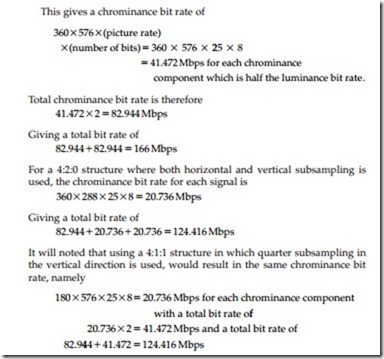The bit rate
Sampling is followed by quantisation where sample values are rounded up or down to quantum values before they are converted into a multi-bit code. The precise number of quantums or levels is determined by the bit depth, the number of bits in the code. For studio applications, 10-bit cod- ing is used. For domestic applications such as TV broadcasting and DVD, 8-bit coding is regarded as adequate. Given a bit depth of 8, the number of discrete signal levels or quantums available is 28 = 256.
The bit rate may then be calculated as follows:
● Bit rate = number of samples per second X number of bits per sample
● But, the number of samples per second = number of samples per pic-
ture X number of pictures per second
● And the number of samples per PAL picture = 720 X 576 = 414,720
● Then, given a picture rate of 25,
Number of samples per second = 720X 576X 25 = 1,036,800
For NTSC, the number of samples is the same, namely
720X 480X 30 = 1, 036, 800
The bit rate generated by the luminance component using an 8-bit code is therefore
= 720X 576X 25X8
= 82, 944, 000
= 82.944 Mbps
The bit rate for the chrominance components depends on the sampling structure used. For a 4:2:2 sampling structure with horizontal subsam- pling only, the number of samples = 360 X 576 = 207,360 per picture.
The actual bandwidth requirements depend on the type of modulation used. However, for pure pulse code modulation (PCM), the bandwidth is half the bit rate, which in this case is in the region of 60 MHz. This is impractically high and clearly illustrates the need for data compression which is the subject of the next chapter.
